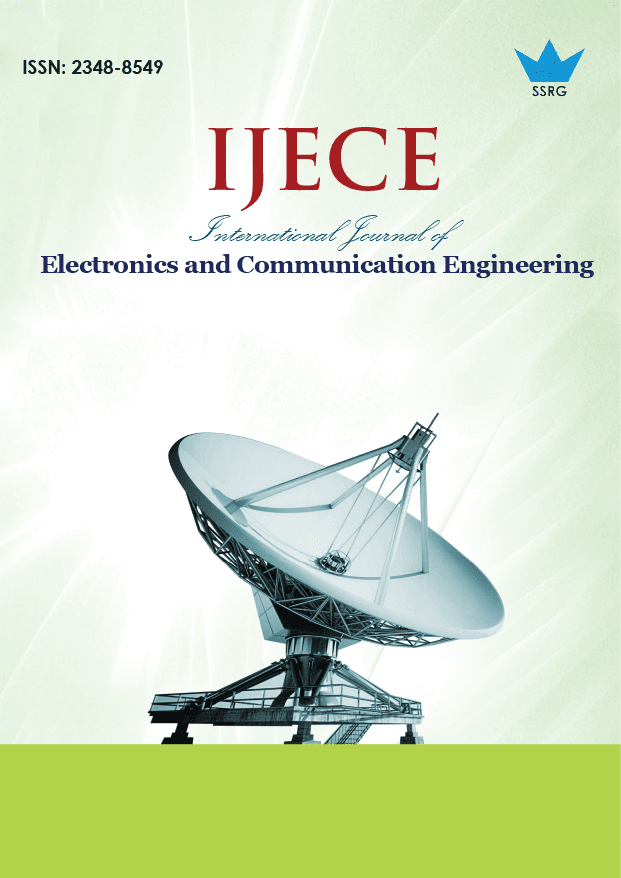Coverage-Enhanced Unknown Area Exploration and Mapping Technique for a Multi-Robot System

| International Journal of Electronics and Communication Engineering |
| © 2025 by SSRG - IJECE Journal |
| Volume 12 Issue 10 |
| Year of Publication : 2025 |
| Authors : Seenu N, Janaki Raman S |
How to Cite?
Seenu N, Janaki Raman S, "Coverage-Enhanced Unknown Area Exploration and Mapping Technique for a Multi-Robot System," SSRG International Journal of Electronics and Communication Engineering, vol. 12, no. 10, pp. 116-128, 2025. Crossref, https://doi.org/10.14445/23488549/IJECE-V12I10P111
Abstract:
An active task distribution algorithm is presented to realize the multi-robot exploration and mapping in new environments. During such missions, when covering unexplored areas, coverage has to be done in an efficient manner to provide a good performance. Inefficient task assignment usually results in the re-use of explored regions by robots. This leads to the wastage of fuel, time, and communication resources. The strategy employed by the proposed approach maximizes area coverage by providing dynamic task assignments so that each robot can target queues or recently covered and unexplored areas. It saves time, increases the productivity of the individual robots, and accelerates the entire mapping process by reducing duplication. The configuration was experimented with using the Robot Operating System (ROS) and the Gazebo simulation platform. These tests were done indoors, where there were obstacles that made the environment realistic. The findings indicated significant increases in the exploration speed, coverage factor, and mapping completion rate as compared to those of the existing methods. After a visual examination of the simulation results, it was clear that very few duplicate paths were obtained. This cements the fact that the allocation technique assists robots in a more efficient operation and with improved resource management. This is achieved through enhanced coverage of areas and reduction of unintended motions, making the multi-robot performance in complicated and unfamiliar terrains. It offers a scalable solution to such applications as search and rescue, environmental monitoring, and autonomous inspection.
Keywords:
Multi-Robot Systems, Dynamic Task Allocation, Exploration of Unknown Territory, Mapping of Unknown Territory, Territory Coverage.
References:
[1] Shengmin Zhao, and Seung-Hoon Hwang, “Exploration- and Exploitation-Driven Deep Deterministic Policy Gradient for Active SLAM in Unknown Indoor Environments,” Electronics, vol. 13, no. 5, pp. 1-19, 2024.
[CrossRef] [Google Scholar] [Publisher Link]
[2] Billy Pik Lik Lau et al., “Multi-AGV’s Temporal Memory-Based RRT Exploration in Unknown Environment,” IEEE Robotics & Automation Letters, vol. 7, no. 4, pp. 9256-9263, 2022.
[CrossRef] [Google Scholar] [Publisher Link]
[3] Yizhen Yin, Hongjun Ma, and Xinkai Liang, “Improved RRT Autonomous Exploration Method Based on Hybrid Clustering Algorithm,” Proceedings of 2021 International Conference on Autonomous Unmanned Systems, pp. 416-425, 2022.
[CrossRef] [Google Scholar] [Publisher Link]
[4] Ao Feng et al., “Efficient Autonomous Exploration and Mapping in Unknown Environments,” Sensors, vol. 23, no. 10, pp. 1-20, 2023.
[CrossRef] [Google Scholar] [Publisher Link]
[5] Shayok Mukhopadhyay, Hassan Umari, and Koshish Koirala, “Multi-Robot Map Exploration Based on Multiple Rapidly-Exploring Randomized Trees,” SN Computer Science, vol. 5, 2023.
[CrossRef] [Google Scholar] [Publisher Link]
[6] Björn Lindqvist, Ali-Akbar Agha-Mohammadi, and George Nikolakopoulos, “Exploration-RRT: A Multi-objective Path Planning and Exploration Framework for Unknown and Unstructured Environments,” 2021 IEEE/RSJ International Conference on Intelligent Robots and Systems (IROS), Prague, Czech Republic, pp. 3429-3435, 2021.
[CrossRef] [Google Scholar] [Publisher Link]
[7] Jun Ding et al., “An Improved RRT* Algorithm for Robot Path Planning based on Path Expansion Heuristic Sampling,” Journal of Computational Science, vol. 67, 2023.
[CrossRef] [Google Scholar] [Publisher Link]
[8] Zeyu Tian et al., “Autonomous Exploration of RRT Robot based on Seeded Region Growing,” 2020 39th Chinese Control Conference (CCC), Shenyang, China, pp. 3936-3941, 2020.
[CrossRef] [Google Scholar] [Publisher Link]
[9] Xiaojing Tian et al., “Robot Autonomous Exploration and Map Building Method,” 2023 International Conference on Robotics and Automation in Industry (ICRAI), Peshawar, Pakistan, pp. 1-6, 2023.
[CrossRef] [Google Scholar] [Publisher Link]
[10] Zezhou Sun et al., “Frontier Detection and Reachability Analysis for Efficient 2D Graph-SLAM Based Active Exploration,” 2020 IEEE/RSJ International Conference on Intelligent Robots and Systems (IROS), Las Vegas, NV, USA, pp. 2051-2058, 2020.
[CrossRef] [Google Scholar] [Publisher Link]
[11] Yusheng Yang et al., “Autonomous Exploration for Mobile Robot in Three Dimensional Multi-Layer Space,” 16th International Conference Intelligent Robotics and Applications, Hangzhou, China, pp. 254-266, 2023.
[CrossRef] [Google Scholar] [Publisher Link]
[12] Lillian Goodwin, and Scott Nokleby, “A K-Means Clustering Approach to Segmentation of Maps for Task Allocation in Multi-Robot Systems Exploration of Unknown Environments,” Proceedings of the 2022 USCToMM Symposium on Mechanical Systems and Robotics, pp. 198-211, 2022.
[CrossRef] [Google Scholar] [Publisher Link]
[13] Ankit Soni et al., “Multi-Robot Unknown Area Exploration Using Frontier Trees,” 2022 IEEE/RSJ International Conference on Intelligent Robots and Systems (IROS), Kyoto, Japan, pp. 9934-9941, 2022.
[CrossRef] [Google Scholar] [Publisher Link]
[14] Kyung Min Han, and Young J. Kim, “Autoexplorer: Autonomous Exploration of Unknown Environments using Fast Frontier-Region Detection and Parallel Path Planning,” 2022 IEEE/RSJ International Conference on Intelligent Robots and Systems (IROS), Kyoto, Japan, pp. 10536-10541, 2022.
[CrossRef] [Google Scholar] [Publisher Link]
[15] S. Suruthi et al., “Evaluating Deep Learning Approaches for MRI Based Brain Tumor Detection,” 2025 6th International Conference on Inventive Research in Computing Applications (ICIRCA), Coimbatore, India, pp. 868-874, 2025.
[CrossRef] [Google Scholar] [Publisher Link]
[16] Vu Pi Tran et al., “Frontier-Led Swarming: Robust Multi-Robot Coverage of Unknown Environments,” Swarm and Evolutionary Computation, vol. 75, 2022.
[CrossRef] [Google Scholar] [Publisher Link]
[17] Priyanka Ankireddy, S. Gopalakrishnan, and V. Lokeswara Reddy, “Gradient-Enhanced Focal-Pooling Vision Transformer with Adaptive Tuning for Robust and Accurate Vehicle Detection in Smart Environments,” Iran Journal of Computer Science, 2025,
[CrossRef] [Google Scholar] [Publisher Link]
[18] Nathanaël Randriamihamison, Nathalie Vialaneix, and Pierre Neuvial, “Applicability and Interpretability of Ward’s Hierarchical Agglomerative Clustering With or Without Contiguity Constraints,” Journal of Classification, vol. 38, pp. 363-389, 2020. [CrossRef] [Google Scholar] [Publisher Link]
[19] Xiangda Yan et al., “Multi-Robot Cooperative Autonomous Exploration via Task Allocation in Terrestrial Environments,” Frontiers in Neurorobotics, vol. 17, pp. 1-13, 2023.
[CrossRef] [Google Scholar] [Publisher Link]
[20] Sheela Pitta, S. Gopalakrishnan, and S. Ravi Chand, “Securing WSN-IoT Networks using SwinAlert-GAN: A Deep Learning-based Intrusion Detection Framework,” 2025 Third International Conference on Augmented Intelligence and Sustainable Systems (ICAISS), Trichy, India, pp. 211-218, 2025.
[CrossRef] [Google Scholar] [Publisher Link]
[21] Lauren Bramblett, Rahul Peddi, and Nicola Bezzo, “Coordinated Multi-Agent Exploration, Rendezvous, & Task Allocation in Unknown Environments with Limited Connectivity,” 2022 IEEE/RSJ International Conference on Intelligent Robots and Systems (IROS), Kyoto, Japan, pp. 12706-12712, 2022.
[CrossRef] [Google Scholar] [Publisher Link]
[22] María Victoria Díaz et al., “Cooperative Indoor Exploration on Affordable Robots,” 2022 Latin American Robotics Symposium (LARS), 2022 Brazilian Symposium on Robotics (SBR), and 2022 Workshop on Robotics in Education (WRE), São Bernardo do Campo, Brazil, pp. 235-240, 2022.
[CrossRef] [Google Scholar] [Publisher Link]
[23] Luiz Eugênio Santos Araújo Filho, and Cairo Lúcio Nascimento Júnior, “Multi-Robot Autonomous Exploration and Map Merging in Unknown Environments,” 2022 IEEE International Systems Conference (SysCon), Montreal, QC, Canada, pp. 1-8, 2022.
[CrossRef] [Google Scholar] [Publisher Link]
[24] Kai M. Wurm, Cyrill Stachniss, and Wolfram Burgard, “Coordinated Multi-Robot Exploration using A Segmentation of the Environment,” 2008 IEEE/RSJ International Conference on Intelligent Robots and Systems, Nice, France, pp. 1160-1165, 2008.
[CrossRef] [Google Scholar] [Publisher Link]
[25] Ranjith Subramanian, Jesu Jayarin, and Arumugam Chandrasekar, “Hybrid Deep Learning Approach for 6G MIMO Channel Estimation and Interference Alignment HetNet Environments,” Traitement du Signal-International Information and Engineering Technology Association, pp. 1951-1960, 2023.
[CrossRef] [Google Scholar] [Publisher Link]
[26] P. Jesu Jayarin et al., “Enhancing Cybersecurity in the Digital Age with Machine Learning for Threat Detection and Prevention,” 2024 International Conference on Recent Advances in Science and Engineering Technology (ICRASET), B G Nagara, Mandya, India, pp. 1-5, 2024.
[CrossRef] [Google Scholar] [Publisher Link]
[27] V. Ragu, and P. Jesu Jayarin, “Detecting Flooding Attacks in Distributed Denial of Service Using Deep Neural Network Compared with Decision Tree,” Innovations In Thermal, Manufacturing, Structural And Environmental Engineering, vol. 3267, 2025.
[CrossRef] [Google Scholar] [Publisher Link]
[28] Graeme Best, Jan Faigl, and Robert Fitch, “Online Planning for Multi-Robot Active Perception with Self-Organising Maps,” Autonomous Robots, vol. 42, no. 4, pp. 715-738, 2023.
[CrossRef] [Google Scholar] [Publisher Link]
[29] C. Lakshmi, and P. Jesu Jayarin, “Design and Implementation of the Reconfigurable Area and Power-Efficient Steganography for Medical Information in MIMO-OFDM Channel Coding,” Wireless Personal Communications, vol. 124, pp. 2271-2298, 2022.
[CrossRef] [Google Scholar] [Publisher Link]
[30] E. Minisha Devi et al., “Innovative IoT-Based Hybrid Electric Vehicle Charging System for Enhanced Efficiency and Sustainability,” 2024 4th International Conference on Ubiquitous Computing and Intelligent Information Systems (ICUIS), Gobichettipalayam, India, pp. 1674-1679, 2024.
[CrossRef] [Google Scholar] [Publisher Link]
[31] N. Seenu et al., “Review on State-of-the-Art Dynamic Task Allocation Strategies for Multiple-Robot Systems,” Industrial Robot, vol. 47, no. 6, pp. 929-942, 2020.
[CrossRef] [Google Scholar] [Publisher Link]

 10.14445/23488549/IJECE-V12I10P111
10.14445/23488549/IJECE-V12I10P111